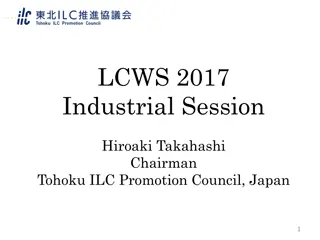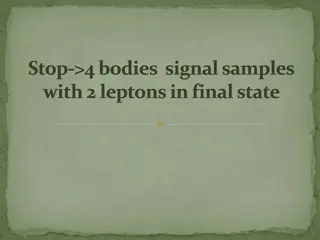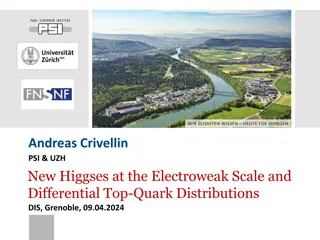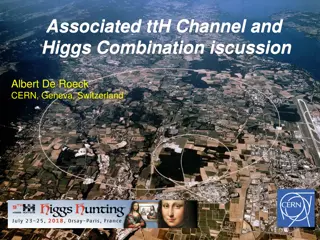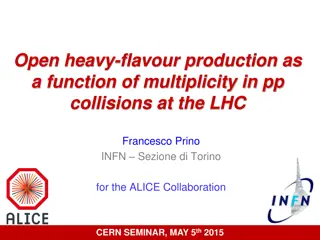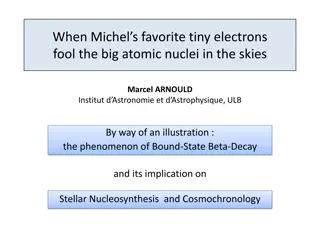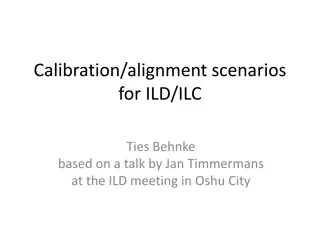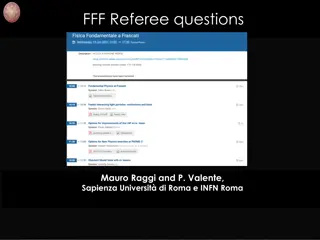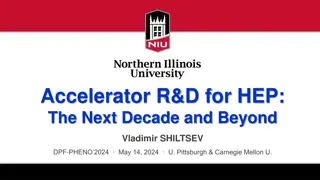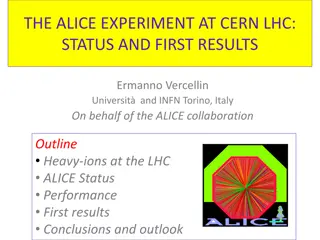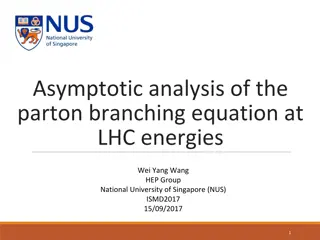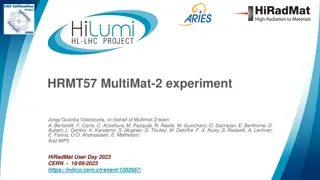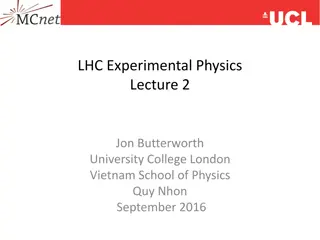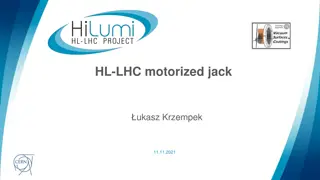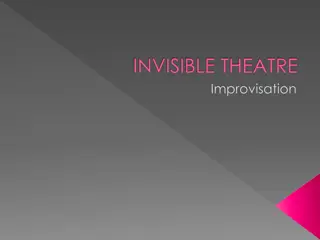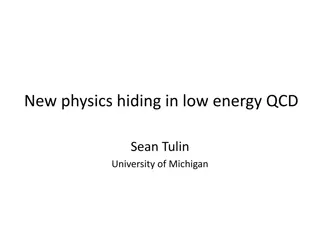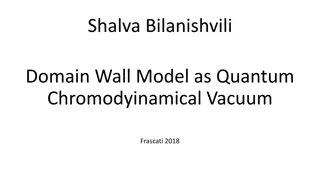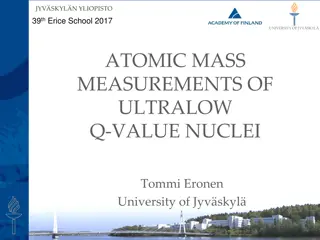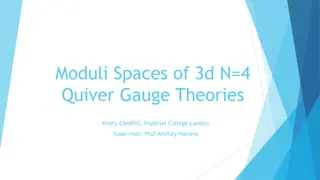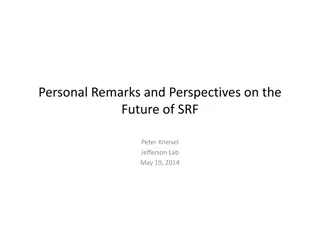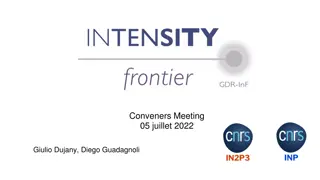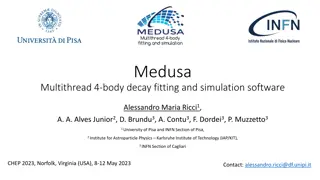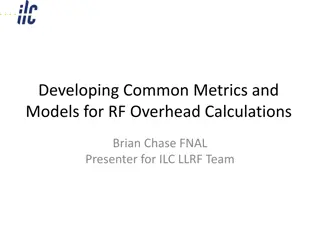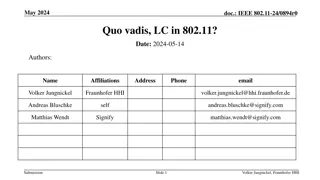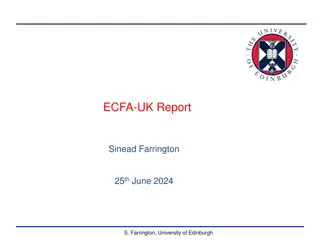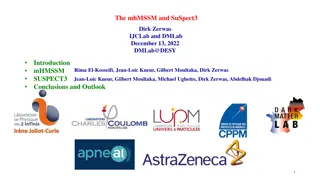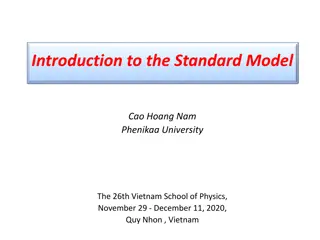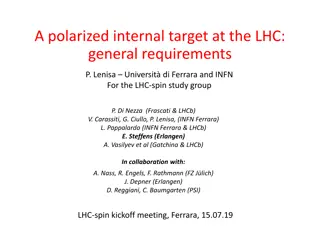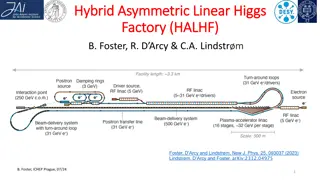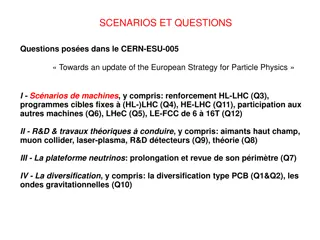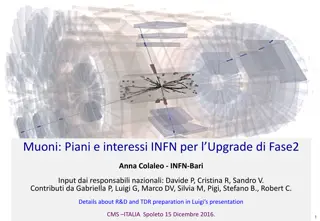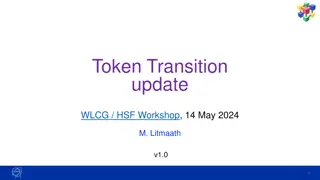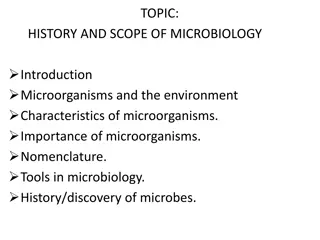Exploring Invisible Higgs Decays: Insights from ILC and LHC
Investigating invisible Higgs decays plays a crucial role in unveiling potential signals of new physics, like Dark Sectors or Dark Matter. The search for invisible Higgs decays at the International Linear Collider (ILC) and the Large Hadron Collider (LHC) involves unique techniques such as recoil mass measurement and model-dependent approaches. Challenges in reconstructing the missing Higgs mass at LHC and the potential of model-independent methods at ILC are discussed. The analysis encompasses detailed examinations of background processes and energy points for maximum cross-section yield, highlighting essential factors in the pursuit of understanding invisible Higgs decays.
Download Presentation

Please find below an Image/Link to download the presentation.
The content on the website is provided AS IS for your information and personal use only. It may not be sold, licensed, or shared on other websites without obtaining consent from the author. Download presentation by click this link. If you encounter any issues during the download, it is possible that the publisher has removed the file from their server.
E N D
Presentation Transcript
Search for Invisible Higgs Decays at the ILC Akimasa Ishikawa (Tohoku University) 20141007 LCWS14@Belgrade
Invisible Higgs Decays In the SM, an invisible Higgs decay is H ZZ* 4 process and its BF is small ~0.1% If we found sizable invisible Higgs decays, it is clear new physics signal, especially, of Dark Sectors Higgs Portal Dark Matter? Cold matter in the universe Dark Radiation? Slight excess (less than 3 ) in effective # of from astro physical observations Relativistic matter in the universe 20141007 LCWS14@Belgrade 2 1303.5076
CMS Collaboration Eur. Phys. J. C 74 (2014) 2980 Invisible Higgs Decays at the LHC Invisible Higgs Decays were searched with qq ZH and qq qqH (VBF) processes using missing Et(and Mqq). They cannot reconstruct missing Higgs mass since they don t know momenta of initial quark pairs This method is model dependent since the cross sections in pp collision are assumed as those in the SM. Current upper limit on BF is 58%@95%CL (expected 44%). Very hard to achieve much better than 10% at the LHC 20141007 LCWS14@Belgrade 3
Invisible Higgs Decays at the ILC Invisible Higgs can be searched using a recoil mass technique with model independent way! e+e- ZH At the ILC, initial e+ e- momenta are known, and the four momentum of Z is measured from di-jet or di-lepton decays, we can reconstruct Higgs mass which is a powerful tool! = P P P + H e e Z measured known In this study Z qq decay is used (BF(Z qq) = 69.9%) Ecm = 250GeV, 350GeV and 500GeV 250GeV results were shown at Snowmass Seattle 2013 20141007 New! LCWS14@Belgrade 4
Cross Section of e+e- ZH qqH Three important energy points 250GeV, 350GeV, 500GeV Two polarization configurations (Pe-, Pe+) (-80%, +30%) = Left (+80%, -30%) = Right The cross section is maximum around 250GeV and decreasing for higher energy ZH Left Right Ratio to 250GeV qqH[fb] 250GeV 210.2 142.0 1 350GeV 138.9 93.7 ~2/3 500GeV 20141007 69.7 47.0 ~1/3 LCWS14@Belgrade 5
q Z e- Backgrounds q (1) e Z Backgrounds found qqll, qql and qq final states are the dominant backgrounds. other backgrounds also studied Pure leptonic and hadronic final states are easily eliminated. q W e Z q - (2) l W e We considered following main backgrounds. (1) ZZ semileptonic : one Z qq, the other Z ll, , (2) WW semileptonic : one W qq, the other W l (3) Z e e, Z qq (4) We e, W qq H, generic H decays qqH, generic H decays e q - W (3) Z q W e + e e - q - (4) W q W e 20141007 LCWS14@Belgrade 6
MC setup, Samples and Cross Sections Generator : WHIZARD Higgs mass 125GeV Pseudo signal : e+e- ZH, Z qq, H ZZ* 4 Samples Official DBD samples + Private Productions (thanks Akiya and Jan) based on DBD setting Full simulation with the ILD detector Half of the samples are used for cut determination. The other used for efficiency calculation and backgrounds estimation. ECM/ [fb] Pol ZZ sl WW sl e eZ sl e eW sl H qqH qqH H 4 250GeV Left 857 10993 272 161 78 210 0.224 Right 467 759 93 102 43 142 0.151 350GeV Left 564 8156 355 4981 99 139 0.148 Right 300 542 73 421 31 94 0.100 500GeV Left 366 5572 559 4853 167 70 0.074 7 20141007 LCWS14@Belgrade Right 190 360 68 572 23 47 0.050
Overview of the Selections for 250GeV (350GeV, 500GeV) 0. kt jet algorithm to eliminate pile-up events only for 500GeV 1. Forced two-jet reconstruction with Durham jet algorithm 2. Isolated lepton veto 3. Numbers of Particle Flow Objects (PFO) and charged tracks NPFO> 16 & Ntrk> 6 Eliminate low multiplicity events like 4. Z mass reconstructed from di-jet : MZ 80GeV < MZ< 100GeV (80 < Mz < 104, 80< Mz < 120) Also used for Likelihood ratio cut 5. Polar angle of Z direction : cos( Z) Just apply < 0.99 (0.99, 0.98) to eliminate peaky eeZ background before making likelihood ratio 6. Loose Recoil mass selection : Mrecoil 100GeV < Mrecoil< 160GeV (100 < Mrecoil< 240GeV, 80 < Mrecoil< 330GeV ) 7. Likelihood ratio of MZ, cos( Z), cos( hel) to give the best upper limit : LR cos( hel) : Helicity angle of Z LR > 0.3 (0.6, 0.6) for Left and LR > 0.4 (0.5, 0.6) for Right 8. Toy MC to set upper limit 20141007 LCWS14@Belgrade 8
Z mass for 250GeV To suppress backgrounds not having Z in final states, Z mass reconstructed from di-jet are required 80 GeV < mZ < 100GeV RMS for Z mass for signal is 10.6GeV and fitted sigma with Gaussian is 5.5GeV Left Left 20141007 LCWS14@Belgrade 9 backgrounds signal
Comparison of Z mass resolution As you see, only 20% difference at peak regions thanks to good jet energy resolution. Please do not take the s seriously since they can be changed by fitting region due to tails. There is a tail for higher side for 350GeV case which is due to pile- up events. could be improved by pile-up reduction with kt jet algorithm For 500GeV, the tail was much improved by kt algorithm but still there. 250GeV =5.5GeV 350GeV =6.0GeV 500GeV =6.6GeV 10 LCWS14@Belgrade 20141007
Background Suppression for 250GeV Likelihood Ratio (LR) method is used to combine three variables Z mass (see previous page) Polar angle of Z direction : cos Z< 0.99 Helicity angle of Z : cos hel LR cos Z cos hel Left Left LR cos Z Left Left cos hel 20141007 LCWS14@Belgrade 11
Final Recoil Mass for 250GeV Dominant backgrounds are ZZ, WW, Z Left Right Right Left 20141007 LCWS14@Belgrade 12
Comparison of signal Mrecoildistributions Higher energy gives worse recoil mass resolution due to luminosity spectrum. Beamstrahlung is larger for higher energy Recoil mass peak is also shifted to higher side. Note. Scale and binning are different 250GeV 350GeV 500GeV 20141007 LCWS14@Belgrade 13
Signal overlaid Mrecoildistributions BF(H invisible) = 10% assumed. Dominant backgrounds are ZZ, WW, Z Right gives smaller backgrounds 250GeV 350GeV 500GeV Left Right 20141007 LCWS14@Belgrade 14
Upper Limits set by Toy MC We performed Toy MC to set the upper limit on BF(H invisible). This invisible does not include H ZZ* 4 Integrated luminosity assumed Ldt = 250, 350, 500fb-1for ECM=250, 350, 500 GeV Corresponding to running about 3 snowmass years (3x107sec) with nominal ILC Left is about 1.5 times worse than Right . 1.52=2.3 times longer running time needed to achieve the same sensitivity 350GeV (500GeV) is about 1.5 (3.2) times worse than 250GeV 1.52=2.3 (3.22=10) times longer running time needed to achieve the same sensitivity UL on BF [%] Left Right 250GeV 0.95 0.69 350GeV 1.49 1.37 500GeV 3.16 2.30 20141007 LCWS14@Belgrade 15
Summary and Plan Full simulation studies of search for invisible Higgs decays at the ILD with the ILC using recoil mass technique are performed e+e- ZH, Z qq processes ECM=250, 350, 500 GeV with Ldt = 250, 350, 500fb-1 Pol(e-,e+) = (-0.8, +0.3) and (+0.8, -0.3) UL on BF [%] Left Right 250GeV 0.95 0.69 350GeV 1.49 1.37 500GeV 3.16 2.30 These results should be also used as a input to running scenario Plan Null polarization for positrons LL and RR polarizations 20141007 LCWS14@Belgrade 16
backup 20141007 LCWS14@Belgrade 17
Constraint? Asymmetric DM Mixing angle of Dark scalar and SM Higgs, and mediator mass Dark radiation together with number of effective neutrinos, gauge structure of hidden sector and scale of dark scalar determined Precision Cosmology meets particle physics. (Dark Radiation) F. Takahashi@Higgs and Beyond Fermionic Asymmetric DM S. Matsumoto@ECFA 2013 20141007 LCWS14@Belgrade 18


